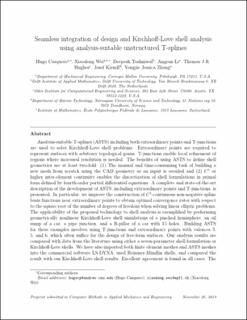| dc.contributor.author | Casquero, Hugo | |
| dc.contributor.author | Wei, Xiaodong | |
| dc.contributor.author | Toshniwal, Deepesh | |
| dc.contributor.author | Li, Angran | |
| dc.contributor.author | Hughes, Thomas | |
| dc.contributor.author | Kiendl, Josef | |
| dc.contributor.author | Zhang, Yongjie | |
| dc.date.accessioned | 2021-10-22T06:35:40Z | |
| dc.date.available | 2021-10-22T06:35:40Z | |
| dc.date.created | 2020-09-17T16:47:30Z | |
| dc.date.issued | 2020 | |
| dc.identifier.citation | Computer Methods in Applied Mechanics and Engineering. 2020, 360 1-34. | en_US |
| dc.identifier.issn | 0045-7825 | |
| dc.identifier.uri | https://hdl.handle.net/11250/2824849 | |
| dc.description.abstract | Analysis-suitable T-splines (ASTS) including both extraordinary points and T-junctions are used to solve Kirchhoff–Love shell problems. Extraordinary points are required to represent surfaces with arbitrary topological genus. T-junctions enable local refinement of regions where increased resolution is needed. The benefits of using ASTS to define shell geometries are at least two-fold: (1) The manual and time-consuming task of building a new mesh from scratch using the CAD geometry as an input is avoided and (2) or higher inter-element continuity enables the discretization of shell formulations in primal form defined by fourth-order partial differential equations. A complete and state-of-the-art description of the development of ASTS, including extraordinary points and T-junctions, is presented. In particular, we improve the construction of -continuous non-negative spline basis functions near extraordinary points to obtain optimal convergence rates with respect to the square root of the number of degrees of freedom when solving linear elliptic problems. The applicability of the proposed technology to shell analysis is exemplified by performing geometrically nonlinear Kirchhoff–Love shell simulations of a pinched hemisphere, an oil sump of a car, a pipe junction, and a B-pillar of a car with 15 holes. Building ASTS for these examples involves using T-junctions and extraordinary points with valences 3, 5, and 6, which often suffice for the design of free-form surfaces. Our analysis results are compared with data from the literature using either a seven-parameter shell formulation or Kirchhoff–Love shells. We have also imported both finite element meshes and ASTS meshes into the commercial software LS-DYNA, used Reissner–Mindlin shells, and compared the result with our Kirchhoff–Love shell results. Excellent agreement is found in all cases. The complexity of the shell geometries considered in this paper shows that ASTS are applicable to real-world industrial problems. | en_US |
| dc.language.iso | eng | en_US |
| dc.publisher | Elsevier | en_US |
| dc.rights | Attribution-NonCommercial-NoDerivatives 4.0 Internasjonal | * |
| dc.rights.uri | http://creativecommons.org/licenses/by-nc-nd/4.0/deed.no | * |
| dc.title | Seamless integration of design and Kirchhoff–Love shell analysis using analysis-suitable unstructured T-splines | en_US |
| dc.type | Peer reviewed | en_US |
| dc.type | Journal article | en_US |
| dc.description.version | acceptedVersion | en_US |
| dc.rights.holder | "This is the authors' accepted manuscript to an article published by Elsevier. Locked until 20.12.2021 due to copyright restrictions. The AAM is made available under the CC-BY-NC-ND 4.0 license http://creativecommons.org/licenses/by-nc-nd/4.0/ " | en_US |
| dc.source.pagenumber | 1-34 | en_US |
| dc.source.volume | 360 | en_US |
| dc.source.journal | Computer Methods in Applied Mechanics and Engineering | en_US |
| dc.identifier.doi | 10.1016/j.cma.2019.112765 | |
| dc.identifier.cristin | 1830957 | |
| cristin.ispublished | true | |
| cristin.fulltext | postprint | |
| cristin.qualitycode | 2 | |

